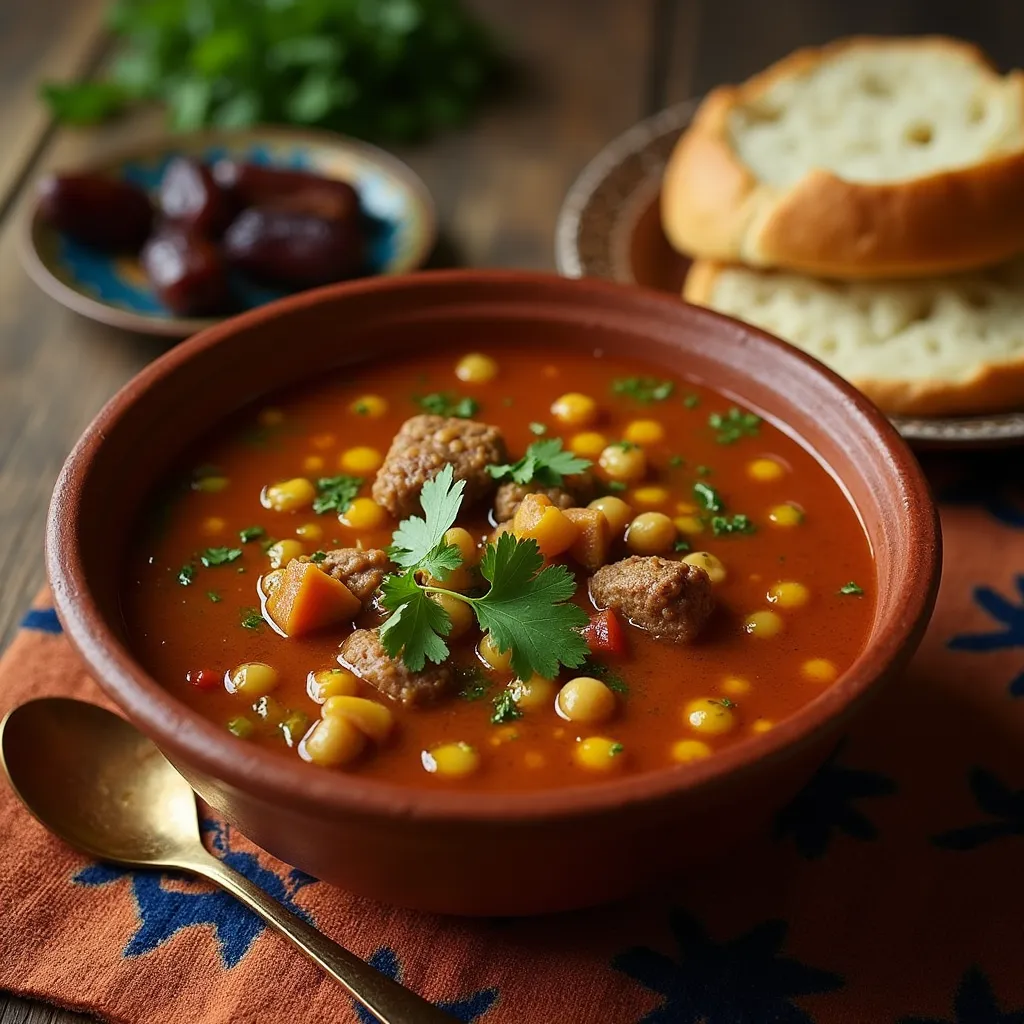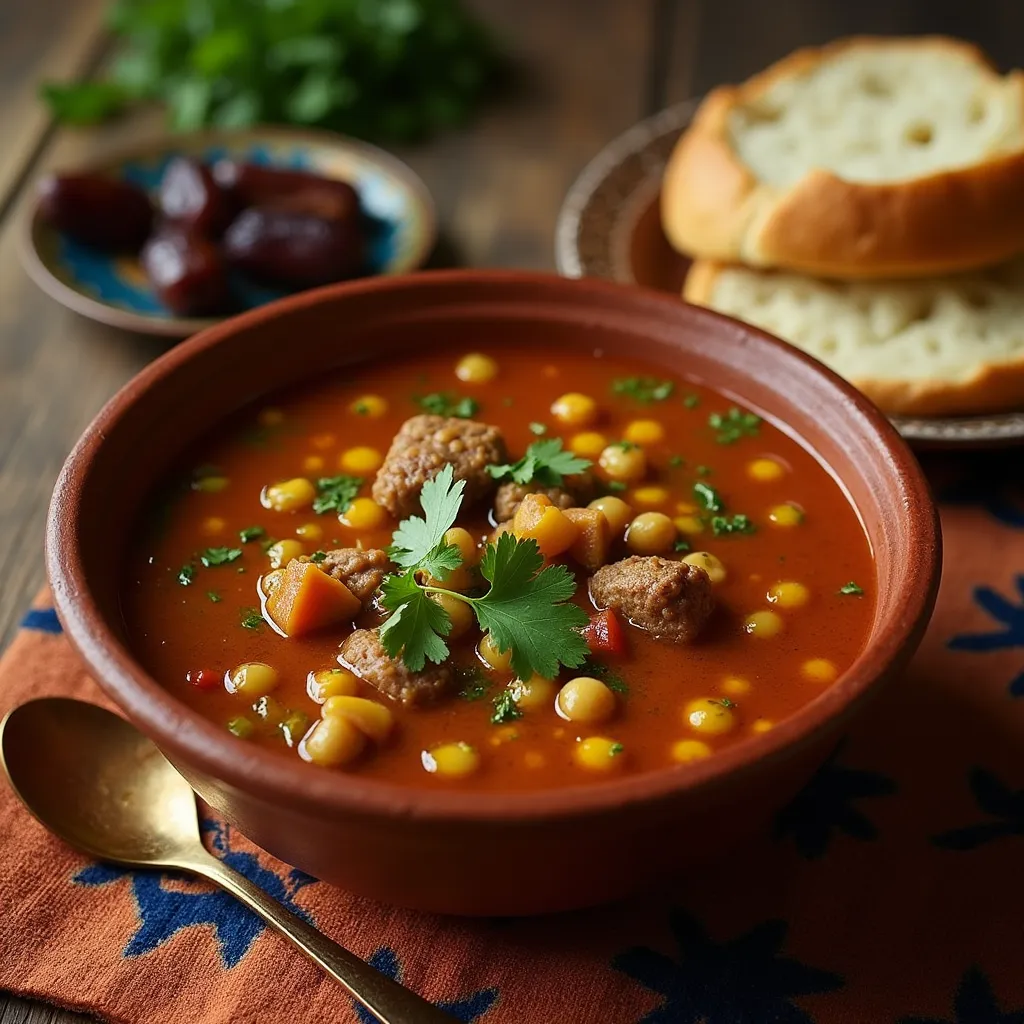 pin it
pin it
I first encountered Harira during a trip to Marrakech during Ramadan, where it was served at sunset to break the fast. I was immediately captivated by its rich aroma and complex flavor profile. The soup has a beautiful rust-red color, thick with tender lamb, chickpeas, and lentils that create a satisfying texture in every spoonful. What makes Harira special is the balance of spices—the warmth of cinnamon and ginger playing against the brightness of tomatoes and fresh herbs. I love how the vermicelli noodles absorb the broth and add another layer of texture. When I returned home, I was determined to recreate this magnificent soup. After several attempts and consultations with Moroccan friends, I finally perfected this recipe that transports me back to that magical evening in Morocco with every batch I make. The secret, I discovered, is in allowing the lamb to simmer slowly and adding the herbs at just the right moment.
Why I love this recipe
I love this Harira recipe because it embodies everything wonderful about cooking—transformation, patience, and cultural connection. The way simple ingredients like tomatoes, lentils, and lamb come together to create something so complex and satisfying feels like magic every time. I appreciate how the recipe uses economical ingredients but produces such a luxurious result. The soup also tells a story—one of breaking bread together, of sustenance after patience, of centuries of culinary wisdom passed down through generations. I'm moved by how the preparation process fills my home with warming aromas, creating a sense of anticipation. There's something meditative about the chopping, stirring, and simmering that forces me to slow down in our fast-paced world. Finally, I love how versatile it is—hearty enough for a main meal yet elegant enough for special occasions. It's a recipe that has earned a permanent place in my cooking repertoire, bringing comfort and joy to my table throughout the seasons.
What You Need From Your Kitchen
- Lamb shoulder: Cut into 1-inch cubes for tender, flavorful bites
- Dried chickpeas: Soak overnight and drain before using
- Lentils: Brown or green varieties work best for this soup
- Tomatoes: Grate them to create a smooth base for the broth
- Vermicelli: Break into small pieces before adding to the soup
- Fresh herbs: Cilantro and parsley provide essential freshness
- Spice blend: The combination of ginger, cinnamon, and turmeric is crucial for authentic flavor
Let's Make These Together
- Prepare the meat and vegetables
- Begin by cutting lamb shoulder into 1-inch cubes, removing excess fat. Finely chop the onions and celery, and grate the tomatoes to create a smooth pulp that will form the base of your soup. This preparation ensures everything cooks evenly and creates the right texture.
- Create the aromatic base
- Heat olive oil in a large pot and sauté the onions until translucent. Add the lamb and brown it on all sides before incorporating the tomato pulp, tomato paste, celery, and spices. This layering of flavors creates the distinctive Harira profile that will develop as it cooks.
- Simmer to perfection
- Add the pre-soaked chickpeas, lentils, and water, then allow everything to simmer slowly. This unhurried cooking process is essential—it tenderizes the meat and allows the legumes to soften while infusing everything with the aromatic spices.
- Thicken and finish
- Create a smooth flour paste and whisk it into the soup to achieve that characteristic thickness. Add the vermicelli and fresh herbs during the final cooking stage to preserve their texture and bright flavor notes.
- Serve with traditional accompaniments
- Ladle the soup into bowls and serve with lemon wedges, dates, and bread. The lemon adds brightness, while dates provide a sweet contrast that balances the savory soup—a traditional Moroccan pairing.
 pin it
pin it
Switch Things Up
I remember the first time I made Harira from scratch. I was determined to honor my Moroccan friend's recipe, but I couldn't find fresh cilantro that day. In a moment of inspiration, I used a mixture of parsley and mint instead, which added an unexpected freshness! Another time, I was cooking for vegetarian friends and substituted the lamb with meaty mushrooms and doubled the chickpeas. The soup developed a completely different but equally delicious character. During winter months, I sometimes add diced sweet potato for extra heartiness. The soup actually tastes better the next day once all the flavors have had time to meld together, so I often make a double batch.
Perfect Pairings
Harira soup pairs beautifully with traditional accompaniments that enhance its rich flavors. Serve it with lemon wedges on the side for guests to squeeze fresh juice into their soup according to taste—the acidity brightens the earthy spices. Dates offer a sweet counterpoint to the savory soup, creating a balance that's especially appreciated when breaking a fast. A loaf of warm khobz (Moroccan bread) or any crusty bread is perfect for dipping. For a complete Moroccan experience, serve mint tea after the meal to aid digestion. If you're hosting guests, consider starting with a simple salad of cucumbers, tomatoes, and olives dressed with lemon juice and olive oil to prepare the palate for the hearty soup to follow.
 pin it
pin it
Frequently Asked Questions
- → Can I make Harira soup in advance?
Yes, Harira actually improves with time as the flavors meld together. You can make it 1-2 days ahead and refrigerate it. The soup will thicken considerably when chilled, so you may need to add some water or broth when reheating. Warm it slowly over medium-low heat, stirring occasionally.
- → How can I make a vegetarian version?
For a vegetarian Harira, simply omit the lamb and use vegetable broth instead of water. Increase the chickpeas and lentils by about 50% for more protein, and consider adding 1-2 cups of diced vegetables like carrots or zucchini. The spice blend remains the same.
- → Can I use canned chickpeas instead of dried?
Yes, you can substitute canned chickpeas (about 2 cups) for convenience. Rinse them thoroughly and add them during the last 30 minutes of cooking to prevent them from becoming mushy. The flavor won't be quite as rich as with dried chickpeas, but it's a good time-saving alternative.
- → Is Harira soup gluten-free?
Traditional Harira is not gluten-free due to the flour thickener and vermicelli noodles. For a gluten-free version, substitute the all-purpose flour with cornstarch (use half the amount) and replace vermicelli with gluten-free pasta or rice noodles.
- → What makes the soup turn red?
The characteristic red color comes primarily from the combination of tomatoes, tomato paste, and spices like turmeric. Using fresh, ripe tomatoes will produce the most vibrant color. Some traditional recipes also include a pinch of paprika which enhances the red hue.
- → Can I freeze leftover Harira soup?
Yes, Harira freezes very well for up to 3 months. Cool the soup completely before transferring to freezer-safe containers, leaving some headspace for expansion. Thaw overnight in the refrigerator and reheat gently on the stovetop, adding a little water if needed to adjust consistency.
Conclusion
Harira is more than just a soup in Moroccan culture—it's a symbol of generosity and celebration. Traditionally served to break the fast during Ramadan, its rich flavors and hearty ingredients make it nourishing enough to be a complete meal. The combination of tender meat, legumes, and aromatic spices creates a deeply satisfying experience that warms both body and soul. Whether enjoyed during festive occasions or as a comforting family meal, this authentic recipe brings a taste of Morocco's rich culinary heritage to your table.
